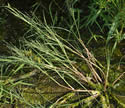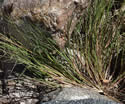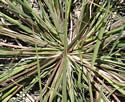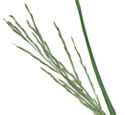Diplachne fusca (Bearded Sprangletop)
| Also known as: | Salt Meadow Grass |
|---|---|
| Genus: | Diplachne |
| Family: | Poaceae (Grass) |
| Life cycle: | annual, short-lived perennial |
| Origin: | native |
| Habitat: | part shade, sun; moist to wet; mud flats, shores, stream banks, roadsides, marshes |
| Fruiting season: | August - October |
| Plant height: | 4 to 40 inches |
| Wetland Indicator Status: | GP: FACW MW: OBL NCNE: OBL |
| MN county distribution (click map to enlarge): |  |
| National distribution (click map to enlarge): |  |
Pick an image for a larger view. See the glossary for icon descriptions.
Detailed Information
Flower: 

![[photo of panicle]](/udata/r9ndp23q/pd3/diplachne-fusca-090417-13-t.jpg) Branching clusters (panicles) at the tips of branching stems, 4 to 12 inches long with 3 to 35 branches. Branches are erect to ascending, sometimes spreading, 1 to 8 inches long, with several spikelets (flower clusters) on a branch and the lowest branches often hidden inside the uppermost leaf sheath. Spikelets are appressed to the branch, short-stalked, slightly flattened, elliptic, 5 to 12 mm (to ½ inch) long with 6 to 12 florets, the uppermost floret usually underdeveloped and sterile.
Branching clusters (panicles) at the tips of branching stems, 4 to 12 inches long with 3 to 35 branches. Branches are erect to ascending, sometimes spreading, 1 to 8 inches long, with several spikelets (flower clusters) on a branch and the lowest branches often hidden inside the uppermost leaf sheath. Spikelets are appressed to the branch, short-stalked, slightly flattened, elliptic, 5 to 12 mm (to ½ inch) long with 6 to 12 florets, the uppermost floret usually underdeveloped and sterile.
![[close-up of spikelet]](/udata/r9ndp23q/pd3/diplachne-fusca-090417-s4-t.jpg) At the base of a spikelet is a pair of bracts (glumes), both 1-veined and rough along the keel, the upper glume lance-oblong, blunt to pointed at the tip, 2.5 to 5.5 mm long, the lower glume lance-shaped, pointed at the tip and about 2/3 as long as the upper glume. Surrounding a floret is a pair of bracts (lemma and palea), the lemma oblong, greenish to whitish usually with a darker gray smudge near the base, 2 to 5.5 mm long, 3-veined, minutely hairy at the base, and a pair of small teeth at the tip with an awn .3 to 1 mm long rising from the notch between the teeth; the palea is about as long as the lemma, 2-veined and hairy along the veins.
At the base of a spikelet is a pair of bracts (glumes), both 1-veined and rough along the keel, the upper glume lance-oblong, blunt to pointed at the tip, 2.5 to 5.5 mm long, the lower glume lance-shaped, pointed at the tip and about 2/3 as long as the upper glume. Surrounding a floret is a pair of bracts (lemma and palea), the lemma oblong, greenish to whitish usually with a darker gray smudge near the base, 2 to 5.5 mm long, 3-veined, minutely hairy at the base, and a pair of small teeth at the tip with an awn .3 to 1 mm long rising from the notch between the teeth; the palea is about as long as the lemma, 2-veined and hairy along the veins.
Leaves and stems: 


![[photo of sheath, ligule and node]](/udata/r9ndp23q/pd3/diplachne-fusca-090417-s13-t.jpg) Leaves are alternate and basal, flat or rolled in along the edges (involute), 10 to 20 inches long, 3 to 5 mm (less than ¼ inch) wide, hairless but rough textured on the surface, tapering to a slender tip. The uppermost leaf usually rises well above the associated panicle. The sheath is thin along the edge and hairless. The ligule (membrane where the leaf blade joins the sheath) is membranous, 3 to 8 mm long, often ragged along the top edge, and lacks a fringe of hairs. Nodes are smooth.
Leaves are alternate and basal, flat or rolled in along the edges (involute), 10 to 20 inches long, 3 to 5 mm (less than ¼ inch) wide, hairless but rough textured on the surface, tapering to a slender tip. The uppermost leaf usually rises well above the associated panicle. The sheath is thin along the edge and hairless. The ligule (membrane where the leaf blade joins the sheath) is membranous, 3 to 8 mm long, often ragged along the top edge, and lacks a fringe of hairs. Nodes are smooth.
![[photo of plant base]](/udata/r9ndp23q/pd3/diplachne-fusca-090417-15-t.jpg) Stems are hairless, multiple from the base forming tufts, usually branched near the base, erect or more often prostrate from the base and rising near the tip (decumbent), rooting at the lower node.
Stems are hairless, multiple from the base forming tufts, usually branched near the base, erect or more often prostrate from the base and rising near the tip (decumbent), rooting at the lower node.
Fruit: 
![[photo of maturing floret]](/udata/r9ndp23q/pd3/diplachne-fusca-090417-s12-t.jpg) As they mature, individual florets drop away leaving the glumes behind on the stalk. Grains (seeds) are elliptic to egg-shaped, 1 to 2 mm long, golden to brown.
As they mature, individual florets drop away leaving the glumes behind on the stalk. Grains (seeds) are elliptic to egg-shaped, 1 to 2 mm long, golden to brown.
Notes:
Bearded Sprangletop, formerly Leptochloa fusca var. fascicularis or Leptochloa fascicularis, has a weedy habit, found mostly in disturbed soils, often where there is a receding waterline along shores, roadside ditches, stream and river banks. We encountered it in a mudflat of the Mississippi River backwaters and at a public boat access in Traverse County. It is likely under-reported in the state. It has a world-wide distribution and is noted as being salt-tolerant, hence one of its common names, Salt Meadow Grass.
Bearded Sprangletop is distinguished from other grasses by the combination of: clump-forming, usually weedy habit, stems usually branched near the base, hairless stems, sheaths and ligules, lower branches of the panicle enclosed in the leaf sheath, spikelets appressed to the branch with 6 to 12 florets, glumes unequal, lemmas to 5.5 mm long with 2 small teeth at the tip and a short awn between them, base of the lemma often with a darker blotch. There are at least 3 subspecies (depending on the reference) of D. fusca, 2 of which are found in North America: subsp. uninervia, present across the southern US, lacks the awn on the lemma; subsp. fascicularis, present across North America, is as described above. When panicles are not present the form is similar to one of the Crabgrasses (Digitaria species), which have broader, shorter leaves and hairy sheaths, at least a few hairs at the tip.
Native Plant Nurseries, Restoration and Landscaping Services ↓
More photos
 Bearded Sprangletop plant
Bearded Sprangletop plant Bearded Sprangletop plant
Bearded Sprangletop plant Bearded Sprangletop plants
Bearded Sprangletop plants scan of upper stem
scan of upper stem spikelets are short-stalked and appressed to the branch
spikelets are short-stalked and appressed to the branch
Photos by Peter M. Dziuk taken in Dakota and Traverse counties.
Comments
Have you seen this plant in Minnesota, or have any other comments about it?






